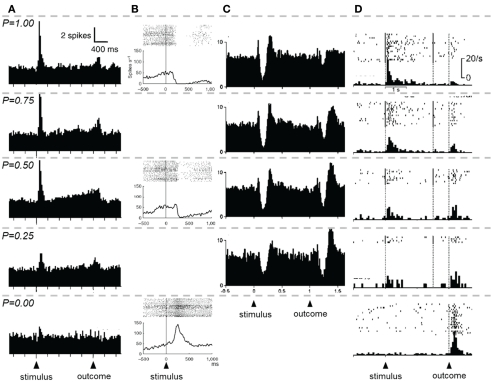Figure 2.
Neuronal responses to reward probability, as demonstrated in four separate experiments. The descending rows represent trials with decreasing reward probability. Each column contains data from a separate experiment. (A) Population responses of dopaminergic neurons of the substantia nigra pars compacta and ventral tegmental area during a Pavlovian conditioning task, as described in Fiorillo et al. (2003). As an abstract visual stimulus predicts reward with decreasing probability, the dopaminergic neurons’ phasic response to the stimulus decreases. In addition a sustained response that increases until the time of reward encodes reward risk. (B) An example of the responses of a single cell in the lateral habenula during a similar task as described in [(A) from Matsumoto and Hikosaka, 2009]. Lateral habenula neurons typically show increased firing rates during the presentation of cues that predict reward with decreasing probability. The task did not include trials with 0.75 and 0.25 reward probabilities. (C) Population responses of tonically active neurons in the putamen, as recorded by Apicella et al. (2009). Stimulus-related reward probability information is encoded in the pause and initial peak of a fraction of tonically active neurons. In addition reward probability exerts strong modulation of suppression and subsequent rebound activity at the time of the outcome. (D) Oyama et al. (2010) recorded from the dorsal striatum of the rat, pairing auditory stimuli with reward in a similar paradigm to Fiorillo et al. (2003). Shown here is a single cell demonstrating analogous reward probability coding to dopamine neurons of the VTA and SN, with the absence of a sustained uncertainty response. Note that for p = 0.00, no stimulus was presented to the animal, but a free reward was delivered. All figures reprinted with permission.

